This day in history 13 November
Images

Mirfield: B1 4-6-0 no 61035, missing its Pronghorn nameplate, stands alongside Mirfield shed (56D) on 13 November 1966. The York based locomotive was withdrawn by BR a month later.
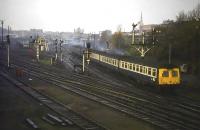
Norwich Thorpe: Daylight is waning and a damp chill is in the air around Norwich station on 13th November 1976. A 'Swindon' DMU set, coupled to a 'MetCam' set, makes a noisy and smoky departure from the terminus heading for Ely and Cambridge.
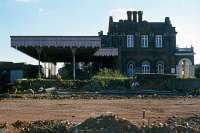
Maldon East: Unseen since the 1970s has been this Witham-facing elevation of Maldon East station. At the time of this photo in 1977, foundations were being laid (visible in the foreground) for a large timber storage shed which soon blocked the view. Part of the platform had also been cut away to make room. By the 21st century, the attractive station building, though still extant, had become hidden away within a cluster of industrial units. See image [[41272]]

Maldon East: In the 1970s, derelict signal boxes on closed lines were quite common around Essex and East Anglia. This example on the Witham to Maldon line used to control the level crossing just outside Maldon East station and the junction for the line to Maldon West and Woodham Ferrers. The view is towards the station, which lies over the road underpass bridge and to the right. The attractive station building has been preserved, but the majority of this scene has been transformed into a busy road and roundabout. See image [[37713]]
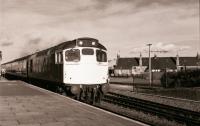
Ladybank: 27036 southbound through Ladybank in Fife, heading for Edinburgh on 13 November 1981.

Markinch: Discussion group under heavy skies at Markinch in November 1981, alongside preserved A4 Pacific 60009 Union of South Africa. The locomotive's home at that time was the shed in the background.

Ladybank: 27036 runs through Ladybank with a southbound train off the Perth line on 13 November 1981.
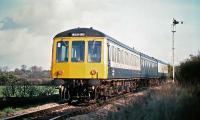
Althorne: A mixed livery and very clean Derby 116 3 car DMU heads away from the camera at Althorne on 13 November 1982. Next stop is Burnham on Crouch, the ultimate goal being Southminster. Electrification works got under way in 1985 and were completed the next year.
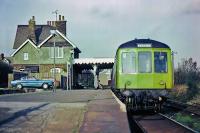
Southminster: A DMU for Wickford pepares to leave Southminster on a bright and chilly 13th November 1982. A rather tidy Ford Capri gleams in the sun. Electrification came to the branch in 1985-86.

Althorne: Manual signaling reduced to its bare minimum is seen at Althorne on 13th November 1982. Situated on the line from Wickford to Southminster, this small frame operated the signals associated with the level crossing at the east end of Althorne station. With no protection from the elements and a relatively frequent train service, we may assume the crossing keeper was of a particularly hardy type.
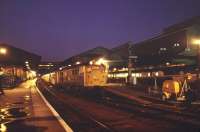
Exeter St Davids: The 20.10 stopping train to Basingstoke about to leave Exeter St Davids on a November evening in 1983.
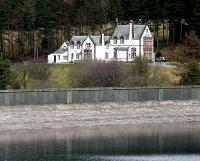
Victoria Lodge: Magnificent Victoria Lodge, built by the men who financed the construction of the reservoir and the railway, stands on the hillside above the terminus. View looking east across Talla dam in 2004.
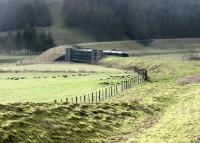
Tweedsmuir Viaduct: The trackbed and viaduct at Glenrusco near Tweedsmuir in 2004 looking towards Victoria Lodge. Closed to rail traffic a century earlier, but still in use carrying a water pipeline from the reservoir the line was built to help construct.
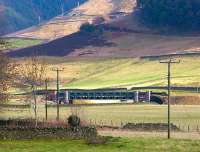
Tweedsmuir Viaduct: The viaduct that once carried the Talla Railway over the Tweed at Glenrusco near Tweedsmuir and which now carries part of Edinburgh's water supply. Photographed in 2004 from a lay-by alongside the A701 road.
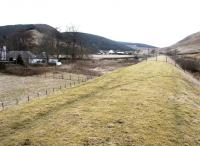
Crook: Looking south east along the trackbed of the Talla Railway between Broughton and Victoria Lodge on 13 November 2004. The old Crook Inn stands off to the left between the trackbed and the A701 road.
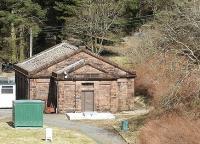
Victoria Lodge: Area below Talla dam in 2004. The remains of Victoria Lodge platform can be clearly seen above the roof of the measuring house.
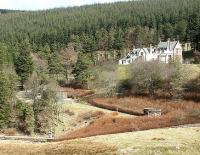
Victoria Lodge: Victoria Lodge terminus and yard in November 2004 showing the platform amongst the trees and the stairway leading up the hillside to the Lodge itself - which must have been cursed by many a trustee arriving for a board meeting.... bless them.
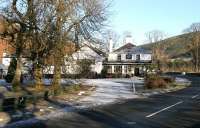
Crook Inn: 'Time gentlemen....PLEASE!' ...the landlord called, from his bunker at the far end of the car park. All part of that special Friday night ambience at the Crook Inn in the early part of the 20th century, thanks to contractor John Best, a wooden platform off to the left and the workers trains from Talla. See image [[6027]]

Cargill Viaduct: The most notable engineering structure on the Caledonian Railway's Strathmore route was Cargill viaduct, Perthshire, which carried the line over the Tay between Ballathie and Cargill. The 5 spans of the viaduct are seen here in November 2005, some 23 years after official closure. View is north west, with the route from Stanley Junction to the left and Coupar Angus to the right.

Cargill Viaduct: Autumn scene at Cargill viaduct, Perthshire, spanning the River Tay on the former Caledonian main line between Stanley Junction and Coupar Angus. The last passenger train is recorded as making the crossing in June 1982. Photographed looking north west on 13 November 2005. See image [[37281]]
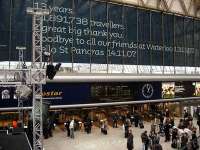
Waterloo International: The western concourse at Waterloo and entrance to the International platforms on 13 November 2007 - the station's final day as a Eurostar terminus.
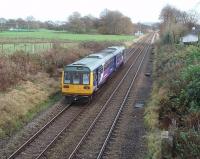
Pleasington: Pleasant Pleasington. Looking east towards Cherry Tree from the overbridge at Pleasington station the open countryside on the outskirts of Blackburn can be seen. 142009 is pulling away on a Colne bound stopping service.

Pleasington: An East Lancashire line stopping service calls at Pleasington on its way to Preston and Blackpool South. Northern Pacers, such as 142054 seen here, still predominate on these services. This view looks west towards Hoghton.

Loughborough Midland: Who said our railways have been rationalized out of all recognition? Here we have a short bay and station sidings on the left see image [[19856]], a barrow crossing in the foreground, an industrial siding (into Brush - above the feathers) in the background, and a four-track main line. The area once occupied by sidings on the left is shortly to host 122 new dwellings. Notice the abbreviation of the Falcon works on the right, to about half the previous length.

Loughborough Midland: Looking South-East over Loughborough station in November 2009. Nice awnings, but needing a lick of Hammerite. Notice the sign and chimney on the Brush Transformers works in the background. see image [[45117]]

Loughborough Midland: The famous neon sign on the Brush Falcon works at Loughborough. Bit of a cluttered foreground. The sign was illuminated on my return, but I ran for the train - it was a 40 minute wait for the next one. Notice that Loughborough is now one of three stations advertising connections to East Midlands Airport. see image [[26414]] Notice also, the handy tower-ette (not Tourette!) for train spotters on the left.

Glasgow Central: Work underway at Glasgow Central on 13 November 2009 involving demolition and clearance of the various structures that have appeared over the years around the base of the station arch on platforms 11 & 12. Further reconstruction work will result in rails being routed through the arch into the the new platforms that will eventually occupy the area previously used as the station car park.

Glasgow Central: The Network Rail office on platform 11 & 12 at Glasgow Central station in the process of being removed on 13 November 2009. In the background stands the archway through which the station's two new platforms will be accessed.

Easter Road Junction: Easter Road Junction see image [[17507]] was situated right at Easter Road station (closed 1947) at the other end of the curve from Abbeyhill Junction. This line allowed trains through Waverley direct access to Leith and Granton, succeeding the more direct cable-hauled line through Scotland Street tunnel. This curve line closed around 20 years ago after it was decided not to electrify the Abbeyhill loop. Nevertheless the sign still stands in November 2010, overlooking the Powderhall branch and no points.
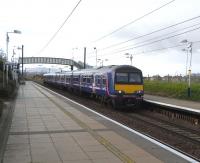
Wallyford: The former mining village of Wallyford is neatly separated from Musselburgh (right) by the ECML, but I'm sure, in the way of these things, that the locals see a lot more to divide them than that. Wallyford has seen a fair amount of private development in recent years and has become more of a dormitory settlement with handy fast rail access to Edinburgh. 322 483 calls with a North Berwick service on 13 November.

Wallyford: Scotrail may have at last painted their first EMU in saltire livery, but here's one that won't be getting a respray. 322 482 pulls into Wallyford on 13 November with a North Berwick to Waverley service. Like the four other members of its Class it'll soon be returning south after spending the prime of its life in Scotland, displaced in the Class 380 rollout.
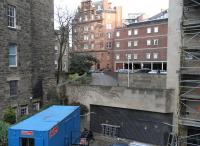
Edinburgh Princes Street: The fine ironwork at the Rutland Street entrance may remain see image [[5528]], but little else of Edinburgh Princes Street does. The station closed in 1965 and after a few years made way for a hotel car park. More recently the site at the end of the platforms became another of Edinburgh's 'financial quarters'. This photograph is taken looking north east towards the buffers on 13 November 2010.

Pilrig Street: An overbridge on the Caledonian's meandering goods branch from Newhaven to Leith Docks once dominated the scene here, running diagonally over a crossroads. Now only a practised eye can spot that the wall on the corner of Bonnington Road and Pilrig Street is a cut-down abutment. Behind it the commercial premises occupy the trackbed which was quickly flattened after closure in 1968 or so, but the embankment still exists at the other side of Pilrig Park see image [[25918]].
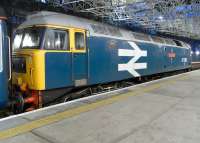
Edinburgh Waverley: 47 580 County of Essex at the head of a Rail Blue tour standing at Platform 2 at Waverley on 13 November 2010. It will return to Leicester with no scheduled stops. Heritage liveries only seem to to be catching up with the present; when you work it out this isn't really true. I think the illusion is just a sign of growing old. Having said that the railfans on this tour were still older than me, as well as being shorter and fatter and with less hair. That will never change.
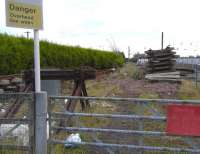
Drem: Drem is barely a village, but serves a fertile agricultural hinterland and had a goods yard which must once have been busy with farm traffic. A siding remains. It is designated an engineers' siding, but here on 13 November it seems more to be more of a dump for old track.
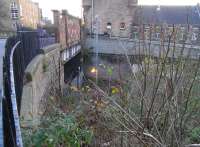
Powderhall: Powderhall station wasn't alone in closing as a First World War economy, but this one never reopened. The building remained pretty much intact until the 1960s when it was flattened, presumably to allow construction of the large refuse disposal works which (and is this irony?) is the only reason the line is still around today. A Binliner wagon can be made out through the vegetation. The bricked-up gates to the platforms from Broughton Road are also discernible in this photograph taken on 13 November 2010. The Scots Baronial-looking building in the background was the former Edinburgh Corporation Refuse Disposal Works see image [[1899]]. Modest, but I suppose in the days of universal domestic fires there was far less refuse to dispose of.

Princes Street [Tram]: The Edinburgh Tram programme is having a few problems as the moment: enough to make the national news. I'll pass on without comment to one of the few reminders of the once extensive tram network the city once built without much fuss, though admittedly things were a lot easier then. Trams making their stately way up The Mound is something remembered by all Edinburgensians who are old enough. The streetlights here at the Foot of The Mound are former trampoles, still with their finials. Before going up Hanover Street (behind the gallery building) the lines had to swing out to the left and curve round before they had enough radius. The swing is still evident in 'stranded' former kerbstones in the pavement on the corner. November 2010.

Wallyford: It does seem a little carbon-inefficient that many long-distance diesel services spend most of their time travelling under wires. However, unless somebody is working on a combined diesel and OHW electric train, or there is a sudden mass electrification programme nothing is likely to change anytime soon. Saving on the electricity bills at least (if that's how it works) 43 319 with the Up Highland Chieftain whiney-roars through Wallyford at speed on 13 November.
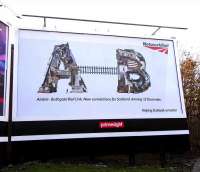
Plates, signs, notices etc: Is fever mounting? This advertising hoarding, photographed on 13 November, is situated near the former Bonnington station in Leith, approximately 20 miles from Bathgate and 2 miles from the nearest station. However, I'm sure the advertisers know their potential market.

Bathgate: 170417 at Bathgate on 13 November with the 18.54 to Waverley.
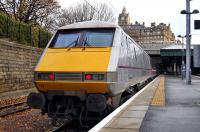
Edinburgh Waverley: East Coast liveried 91107 brings up the rear of the 09.30 Edinburgh - Kings Cross on 13 November 2010.

Drem: 322 481 approaches Drem with a North Berwick to Waverley service. The five 322s are doomed, in Scotland anyway, but I'm cagey about dates as it seems to depend on the rollout on the A-B line.
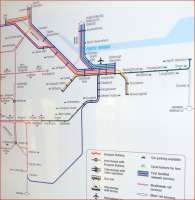
Central Scotland: A snapshot of the east end of the central Scotland ScotRail network map, photographed on a Class 322 on 13 November 2010. It will be interesting to note how they cope with Airdrie - Bathgate. Apropos of nothing, Croy looks like a major rail interchange whereas in fact no trains at all terminate there.

Drem Junction: Probably like everyone else who has stood on this bridge over the start of the North Berwick branch I wish it were a little nearer the junction. However, make the best of it. An East Coast 225 cuts through the flat countryside of northern East Lothian with a King's Cross service on 13 November.

Bonnington Goods: The goods line which left the NBR North Leith branch just to the east of Bonnington station was many branched, but it crossed the Water of Leith only once.� The southern abutment of the bridge is seen here on 13 November.� Nearby is a lifelike statue of a naked man standing in the river.� It was rather unnerving being alone with him, particularly as he was clearly not feeling the cold.

Farington Junction: Engineering possession on the fast lines at Farington Junction on 13 November 2011 as a southbound Class 185 to Manchester Airport passes on the up slow. For a similar daylight view from 2007 see image [[16522]].

Farington Junction: Looking south along the WCML with Farington Junction immediately behind the camera. The crossover between the up and down fast has been severed as a result of the track replacement on the down fast on the first Sunday of engineering work, 13 November 2011. To the right are the slow lines which remained open throughout. For a daylight shot from the same position a few years ago see image [[23839]].

Woodacre Crossing: Lizzie retraces her steps to Crewe from Glasgow with Day 2 of The Coronation Scot tour from Birmingham. As the sun sets 6201 passes Woodacre with Brush Class 47 D1755 again bringing up the rear. See image [[36386]] for the previous day's northbound train at the same location.

Arpley Junction: Having just run round its train of empties from Fiddlers Ferry at Latchford Sidings, DBS 60040 runs back through Arpley Junction but turns left for Arpley Yard.
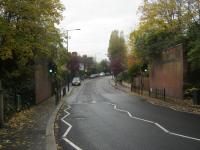
Palace Gates Wood Green: Surviving abutments that supported the bridge carrying the former Seven Sisters to Palace Gates (Wood Green) branch in north London over Park Avenue, just to the south of the site of Palace Gates (Wood Green) station, looking south-west on 13th November 2012. The line opened in 1878 and was closed to passengers in 1963 and to freight in 1964. This old bridge is one of the few surviving memorials to the line. However, if Crossrail 2 should ever get built - and don't hold your breath - the proposed New Southgate branch will virtually follow exactly the route of the old Palace Gates line but presumably below ground.
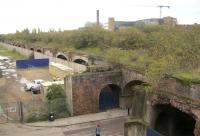
Bishopsgate: The former Eastern Counties Railway viaduct of 1840 that led into and out of the line's original terminus, opened in 1840 as Shoreditch and renamed Bishopsgate the following year, seen here looking east from the new London Overground Shoreditch High Street station on 13th November 2012. The station became a goods station in 1876 after the extension to Liverpool Street was fully opened by the GER and which dived down beneath the original terminus and on which two low level platforms were opened. These closed as a First World War economy in 1915 and never reopened although one platform is still well maintained for use as an emergency exit. The original terminus which became Bishopsgate High Level survived as a goods station until severely damaged by fire in December 1964 and in which two railway workers tragically lost their lives. See image [[71235]]
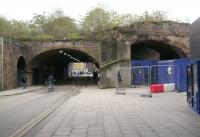
Bishopsgate: The former Eastern Counties Railway viaduct of 1840 that led into the original terminus opened as Shoreditch in 1840 and renamed the following year and which became a goods station from 1876 onwards after Liverpool Street station was fully completed, having partly opened the previous year. The viaduct fell into disuse after a disastrous fire, in which two railway workers sadly lost their lives and which rendered the goods station no longer viable, in December 1964. This view from outside the new London Overground Shoreditch High Street station, opened in April 2010 (out of view on right) is on 13th November 2012. See image [[71224]]
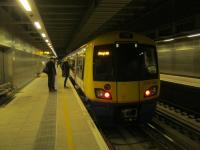
Shoreditch High Street: 378135, with a London Overground service to Highbury & Islington, calling at Shoreditch High Street station, on 13th November 2012. This station opened in April 2010 and is on the then new link between the former North London Railway's Broad Street viaduct, closed in 1986 and which was partially reopened, and the former London Underground East London Line.
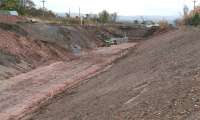
Eskbank: Looking south towards the proposed site of the new Eskbank station on 13 November 2013. Hardengreen roundabout is just over half a mile beyond the current limit of the recently re-excavated cutting, where work is nearing the old infilled bridge.
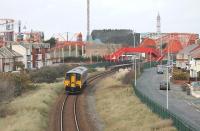
Blackpool Pleasure Beach: It's Movember 2013. Northern Rail is supporting the men's health charity but its not just the staff who are growing facial hair. Sprinter 150215, seen here leaving Blackpool Pleasure Beach, is one of a number sporting moustaches on the gangway doors this month.
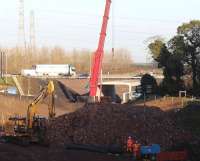
Sheriffhall City Bypass Overbridge: The 'concrete box' through which the Borders Railway will pass, positioned in the breach on the Edinburgh City Bypass at Sheriffhall on 13 November 2013. Traffic in the background is on the temporary diversion route.
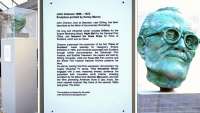
Stirling: A bust of documentary filmmaker John Grierson, by artist Kenny Munro, currently located on the footbridge at Stirling station. Photographed on 13 November 2013.
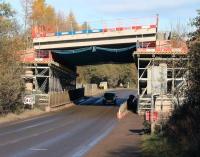
Gore Glen Bridge: With its recently added deck now in place, the Gore Glen bridge spans the A7 on 13 November 2013.
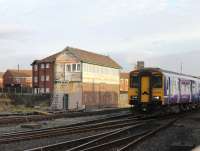
Blackpool North: The last surviving Blackpool signal box, L&YR built North No.2, is looking decidedly shabby but will disappear with the forthcoming electrification and so is unlikely to be spruced up. Northern Movember embellished Sprinter 150206 approaches the platforms at Blackpool North on a sunny morning in November 2013.
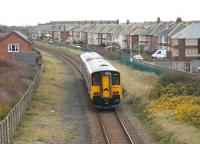
Blackpool Pleasure Beach: Heading for Squires Gate though the Blackpool suburbs on 13 November, embellished Sprinter 150215 is seen from the Harrowside road bridge. Northern Rail recently announced that it had raised over £10,000 for men's health charities during Movember.
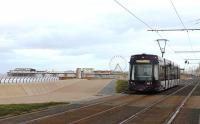
Manchester Square [Tram]: A cold and breezy November morning sees a near deserted promenade at Blackpool as Flexity 008 heads north towards the Central Pier near Manchester Square. The 10 minute interval service between Starr Gate and Fleetwood is maintained until the illuminations close but supplemented by shorter workings on the central section at busy periods.
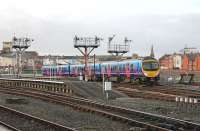
Blackpool North: Six of the eight semaphore signals that control departures from the platforms at Blackpool North are seen here on 13th November 2013. They will not survive electrification, due for completion in May 2016. TPE 185107 leaves Platform 7 with the hourly Manchester Airport service.

Penistone: Looking east towards Penistone station in November 2014 along the Trans Pennine Trail, that runs along a narrowed strip of the Woodhead route trackbed until, some 50 metres behind camera, it then widens out to utilise the full width of the old trackbed. The old goods shed stands on the right, with coal drops beyond to its left. Addendum The goods shed had been demolished between this visit and a visit in May 2018. See image [[68096]]
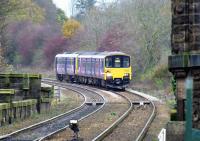
Knaresborough Viaduct: The 14.15 for York approaches Knaresborough on 13 November 2014, complete with moustache for 'Movember'. The last two vehicles are Class 142 Pacers, or 'nodding donkeys'. Being in one of these was akin to riding in a mineral wagon at Waterside.

Penistone: Looking north west towards the old coal drops at the east end of the former Penistone goods yard, sited some distance west of the station. The old railway bridge crosses the B6462, which links the town centre and the main A628 Barnsley to Manchester road. [Ref image 6777]
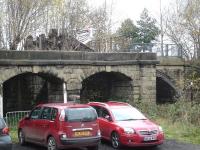
Penistone: The substantial remains of the hardwood stop blocks for the former coal drops at Penistone goods yard on 13 November 2014. The centre arch is showing warning signs of a potential future collapse.
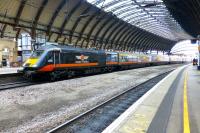
York: A Grand Central HST bound for Sunderland calls at York on 13 November 2014.
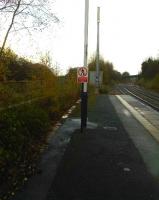
Pontefract Baghill: Looking north east along the down platform at Pontefract Baghill station on 13 November 2015, with the edge of a disused bay visible to the left. The bay was for a service that ran over Bondgate viaduct to join the Wakefield to Goole route by Monkhill station. The section of line leading from the S&K to the viaduct now forms part of the large Cott soft drinks plant site. [Ref query 36938]
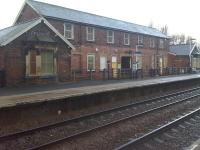
Pontefract Baghill: Looking north to the large down side station building at Pontefract Baghill which now has a more road based usage compared to its original purpose; with the far half now used as a DSA Driving Test Centre. The entrance tunnel to access the platforms can be seen at the centre of the main building, with the lighter coloured lower brickwork previously being below a full length canopy running between the wings at each end. Cast canopy support pillars are still in place.
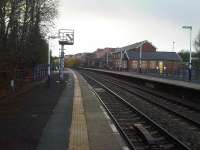
Pontefract Baghill: Looking south west on the up side showing the lengthy platforms that exist at Pontefract Baghill station, with the subway ramped access visible to either side. The platforms reflect the years when it was a main line station - and could be again by extending most Midland Main Line services to York, rather than have a two coach train shuttling between there and Sheffield.
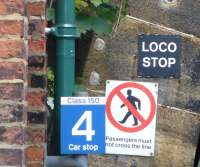
Knaresborough: Signs at the end of the York bound platform at Knaresborough station in November 2014. [Ref query 6557]
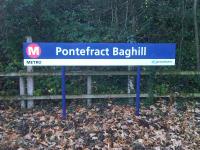
Pontefract Baghill: View of the up side running in board at Pontefract Baghill Station, which is replicated over the entrance to the tunnel through the main building providing access to the platforms.

Pontefract Baghill: A view from the adjacent road showing the large but rather bland frontage to Pontefract Baghill Station. The left half of the main building and the single storey wing are in use as a driving test centre, whilst the right side is in occasional railway use. The entrance to the platforms is through a small tunnel in the centre of the main building, with a replica of the station running in board mounted over the tunnel entrance.
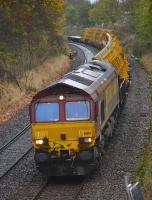
Dalgety Bay: 66154 nears Dalgety Bay with a late-running Stirling Middle - Carlisle New Yard engineers train conveying specialist wagons for carrying prefabricated turnouts.
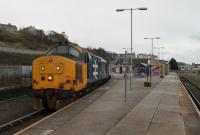
Whitehaven: 37401 pauses at Whitehaven on 13th November 2017. The train is the 1140hrs 2C49 Barrow to Carlisle service, the second of three northbound trips for the Class 37 that day on a diagram that starts in Barrow and finishes in Carlisle.

Clayhills Yard: A long way has been travelled since the stylish days of GNER and East Coast. Virgin new sign at Clayhills Depot, Aberdeen, on 13th November 2017.

Dalton Junction: Dalton Junction signalbox, seen from the passing 2C47 Preston to Barrow-in-Furness service on 13th November 2017. 37402 is just passing the tracks that diverge right towards Park South Junction. This short line, a few hundred yards long, allows direct freight trains and excursions to avoid the lengthy detour through Barrow station.
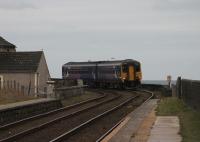
Parton [WJR]: 156448 negotiates the the check railed curve on the last stretch of the sea wall north of Whitehaven as it approaches the request stop at Parton. The train is a Barrow to Carlisle service on 13th November 2017.
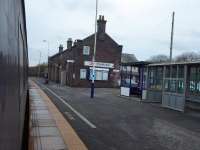
Corkickle: Corkickle station, now an unstaffed halt serving the south area of Whitehaven. The old station building is seen from a Cumbrian Coast train heading for Barrow-in-Furness in November 2017.
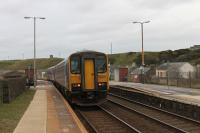
Parton [WJR]: 153301 is on the rear of a two-car set as it departs Parton heading for Carlisle on 13th November 2017. You can see by how much of the train underframe is showing that the platforms at Parton are particularly low but the Harrington Humps have allowed services to continue without great expense.
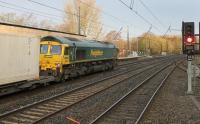
Lancaster: Freightliner 66551 rolls a Daventry to Mossend intermodal service through the Down Fast line at Lancaster station on 13th November 2017.

Parton [WJR]: David Hindle's new book, Enjoying the Cumbrian Coast Railway, will be published in December 2017. See image [[61899]]. Currently the best way to enjoy the route is on one of the Class 37 hauled passenger trains, but only until January 2019. The DBSO is leading this set along the exposed single track section at Parton, with the locomotive providing the sound effects at the rear. St. Bees Head can be seen in the distance as the train runs south heading for Barrow-in-Furness on 13th November 2017.
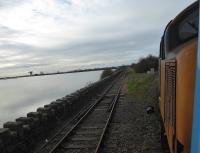
Salthouse Junction: View of the Barrow Docks branch at Salthouse Junction from the 2C47 Preston to Barrow service on 13th November 2017. The line still sees traffic on an as required basis. This is primarily imported nuclear loads to be taken to Sellafield for reprocessing.
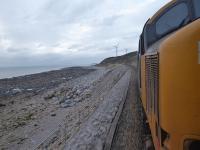
Parton [WJR]: The line between Parton and Harrington has the Irish Sea on one side and crumbling cliffs on the other. Part of this stretch was reduced to single line a number of years ago to ease maintenance. 37401 propels 2C34 Carlisle to Barrow along the single line section, which has a 15mph speed limit, on 13th November 2017.
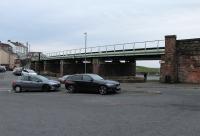
Harrington: The impressive curving viaduct at Harrington, looking south from the landward side on 13th November 2017. The structure was extensively rebuilt in 2004 (according to the blue plaque displayed on a bridge pier).
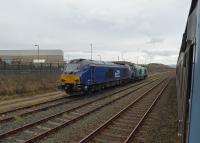
Sellafield: DRS 68029 and 68019 on a stabling road outside the Sellafield plant between flask train duties. 13th November 2017.
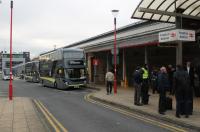
Preston: With the Blackpool line closed for electrification frequent rail replacement buses are running each day from Preston. Some buses run direct to Blackpool North and others call at the intermediate stations on both Blackpool lines. This was the scene outside Preston station side entrance on 13th November 2017.
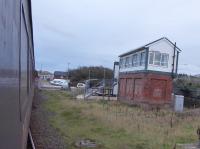
Whitehaven: Nowadays the LNWR style cabin at Whitehaven (Bransty) only controls a limited number of signals and points in the station area but it has also gained responsibility for the single line section north towards Parton and south to St. Bees. Seen here from a southbound train approaching the station on 13th November 2017.
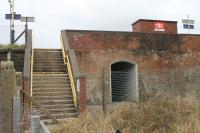
Parton [WJR]: The rather uninviting entrance to Parton station between Whitehaven and Workington. The Harrington Humps providing level access to the trains seem a little superfluous when these stairs need to be scaled to reach the trains, although in fairness the platforms are very low indeed. 13th November 2017. [Ref query 14 November 2017]
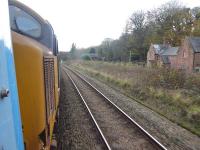
Furness Abbey: What appears to be the old Ulverston platform is visible in the undergrowth as the Preston to Barrow train rounds the curve at Furness Abbey on 13th November 2017. The station closed in 1950 and the Barrow platform, which was staggered and on the other side of the level crossing, has been completely removed.
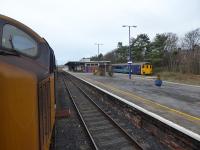
Barrow-in-Furness: Probably a unique occurrence now, the 1004hrs from Preston arrives in Barrow-in-Furness behind 37402 while the onward connection to Whitehaven and Carlisle waits in Platform 3 behind 37401 (out of sight) for connecting passengers. 37402 will depart to the carriage sidings before working north in the afternoon. I don't think there's another UK location where you can transfer from a 37 hauled train into another one to continue a journey but you can do it in Barrow Monday to Friday (for now).
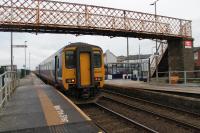
Harrington: 156448, working from Barrow to Carlisle, stands alongside one of the original Harrington Humps at the station of the same name. Still not exactly level access but much easier to get in at the rear door than the others. 13th November 2017.
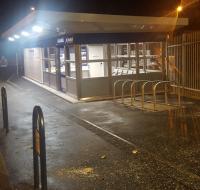
Blairhill: An evening view of the new building at Blairhill, which has recently come into use.
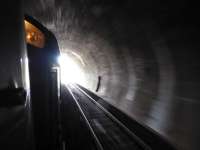
Dalton Tunnel: The light in the rear cab of 37402 is visible as it heads through Dalton Tunnel on its way to Barrow-in-Furness with train 2C47 from Preston on 13th November 2017.
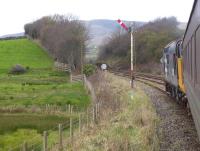
Foxfield: Immediately north of Foxfield station the railway swings sharply to the west to cross the Duddon Estuary before turning south for Millom. 37401 is just passing the Foxfield Advance Starter with the 2C49 Barrow to Carlisle service on 13th November 2017. The bridge over the Duddon is just beyond the small cutting seen here.
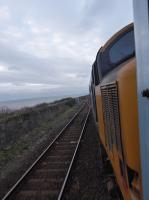
Parton [WJR]: 37401 propels the 2C34 Carlisle to Barrow service off the single line coastal section between Parton and Whitehaven on 13th November 2017. The Indian Summer of Class 37 passenger services is drawing to a close. No final date has yet been set but January 2019 has been mooted as when Class 195 deliveries will allow sufficient Class 156 Sprinters to be cascaded to the Cumbrian Coast. Time will tell.
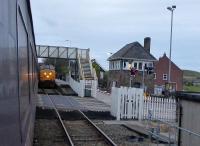
St Bees: Class 37 hauled Cumbrian Coast services pass at St Bees on 13th November 2017. The substantial signal box controls the passing loop between the single line sections from Whitehaven and Sellafield, and the level crossing.
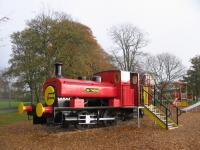
Seaton Park: This photograph is in Seaton Park, Aberdeen. The loco appears to be the former Gas Board engine 'Mr Therm' which worked the dock railway system. See image [[38697]].
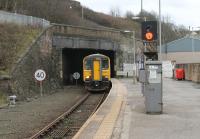
Whitehaven: The tunnel entrance at Whitehaven is misleading, as a girder bridge of double track width conceals the single track bore that runs to Corkickle. 153352 emerges to call at Whitehaven on its way to Carlisle with a coastal stopping service. The signal isn't controlled from Bletchley of course but Bransty signalbox, which was the original supplementary name of this station.
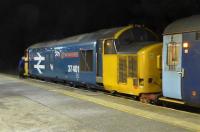
Barrow-in-Furness: 37401 has just arrived from Carlisle in Platform 3 at Barrow-in-Furness, but had been delayed at Park South Junction waiting for the single line to clear. Hence there is a quick turnaround and the driver is climbing aboard for the return journey. 2C47 is the 1731hrs departure for Carlisle, the last northbound Class 37 of the day. 13th November 2017.
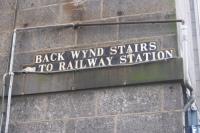
Aberdeen: Aberdeen's traditional street signage points travellers south from Union Street on 13th November 2017.
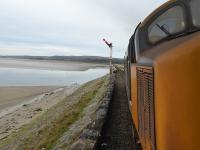
Arnside: The view onto the Kent viaduct as 37402 passes the Arnside advance starter with 2C47, Preston to Barrow-in-Furness on 13th November 2017.

Harrington: Harrington Humps are now used at smaller stations with low platforms across the UK network but this is where they were first installed. This view looks south at the unstaffed Cumbrian Coast halt at Harrington on 13th November 2017.
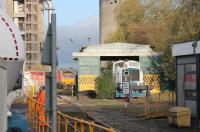
Horrocksford Limestone Quarry: There are two resident diesel shunters at the Hanson Cement plant near Clitheroe but train locos seem to be used to draw their cement tankers through the loading facility. As the shunters stand idle GBRf 66702 Blue Lightning can just be seen manoeuvring its train on 13th November 2019.
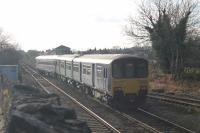
Horrocksford Junction: Regular trains to Clitheroe returned in 1994, after an absence of 32 years, and so have been back in the town for 25 years now. This is 5J27, a Clitheroe to Clitheroe ECS movement, drawing forward over the points at Horrocksford Junction before forming a service back to Rochdale via Manchester on a surprisingly bright 13th November 2019. The 153/142 combinations are quite common on these services.

Loch Park Siding: A view looking south from the Brougham Place bridge, about 1/2 mile south of Hawick station, in November 2019. The short path from Morrison's roundabout on the line finishes here as the low bridge has been demolished. It restarts on the other side and continues to just before the site of the old Slitrig Viaduct.
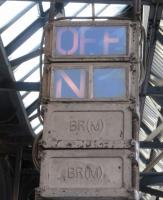
Dundee: LED ‘OFF’ indicators have been appearing on platforms which never had them before. The old-style versions are usually replaced where they already existed, but not here at Dundee where the signalling is surely due for upgrade. Notice BR(M) for Midland Region; for some reason Scottish Region never had any of its own brand (Sc) when other regions did.
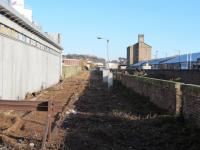
Dundee East: Dundee East station occupied the site of the building on the left and squeezed between it and the lines from Tay Bridge station (in the cutting over the wall) were two tracks which once continued along Dock Street. One is still there, though long out of use and cut back even longer ago. This was very overgrown until quite recently; I'm not sure what has prompted the devegetation here and across the other tracks from Camperdown.
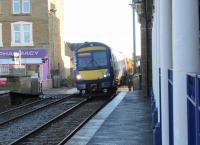
Broughty Ferry: An Arbroath to Edinburgh service crosses Gray Street and into Broughty Ferry station on 13 November 2019. The road is not particularly busy with traffic, but its as well there is a pedestrian underpass as there are always a lot of people about.
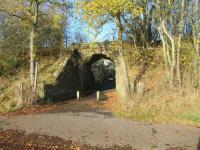
Broughty Junction: The Forfar direct line left the Dundee & Arbroath on the 'wrong', southern side and climbed before swinging over it at Barnhill [Angus]. This was probably because the land on the seaward side would have been cheaper as it wasn't built on. This spot is between the Junction (left) and the flyover and looks under the old Forfar line towards the D&A.
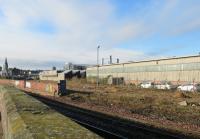
Camperdown Junction: Camperdown sidings (more or less the old platforms lines of Dundee East) have gone from 'NIRU' to 'OOU' in Track Diagrams but have recently had vegetation cleared. I think we can rule out a reopening of Dundee East, so unless this has just been done for aesthetic reasons (!) some plans are afoot.The line to Dundee station descends sharply in the foreground; Camperdown Junction is behind me.
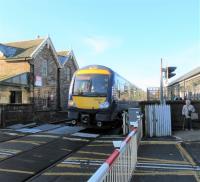
Broughty Ferry: An Edinburgh to Arbroath service pulls out of Broughty Ferry station and across Gray Street on 13 November 2019. There is a pedestrian underpass to keep people moving while the barriers are down, but of course the steps are not suitable for everyone and at least one person here prefers to wait.
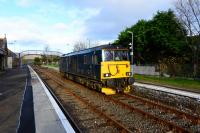
Brora: Southbound route learning 73968 waits at Brora Station for a northbound passenger to pass. 13/11/20.
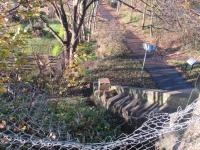
East Pilton Halt: Having bought their ticket at the East Pilton 'potting shed' at the top of the other platform stairs, passengers for Princes Street would make their way down the wooden steps here. Note the brick supports. Lack of tram competition here may have influenced the opening of the halt in 1934, but it closed with the rest of the branch in 1962.
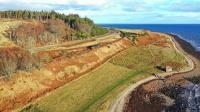
Dunrobin Castle: 73968 on driver route learning duties, pictured heading south midway between Brora and Dunrobin Castle, 13th November 2020.
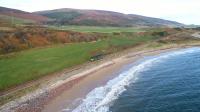
Loth: Another outing for 73968 as a driver route learner from Inverness to Georgemas Junction, in preparation for engineering work. Pictured just south of the former Loth station on the east coast between Helmsdale and Brora on the way back to Inverness on 13th November 2020.
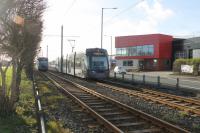
Stanley Road [Tram]: Flexity trams 015 and 013 pass outside Fleetwood fire station, immediately to the south of the Stanley Road stop, on 13th November 2020. See image [[44155]] from this location in 2013.
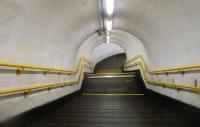
Essex Road: Essex Road, on the former Great Northern & City Railway from Finsbury Park to Moorgate, dating from 1904, is unusual in that passengers have to go DOWN from the platforms to the lifts before they can go up to the street. And as can be seen in this view looking down, on 13th November 2021, the stairs are on the steep side, especially when going UP and hardly suitable for people with reduced mobility. Probably explains why this station is so little used, which adds greatly to its rather spooky atmosphere.
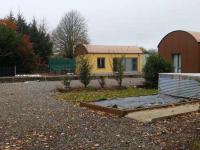
Farrangalway: Farrangalway station, now a private house with the converted former waiting room on the Kinsale Junction platform side visible. If you look closely you will find the letters for the station name-board a little jumbled up to the left of the trampoline. View looks west with Kinsale to the left and Ballymartle and Crossbarry (Kinsale Junction) to the right. Opened in 1863, the station closed in 1931.
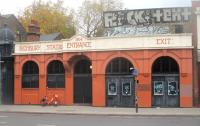
Highbury and Islington: The former entrance (and exit) to the Great Northern & City Railway's 1904 Highbury station still stands on Holloway Road, seen here on 13th November 2021. This opened in June 1904, three months after the line, as Highbury, despite the NLR station across the road being known as Highbury & Islington, but the GNCR station eventually followed suit and '& Islington' was added in 1922, but this building remained as plain Highbury. It ceased to be used in 1968 when the Victoria Line opened from Walthamstow Central and the lifts were replaced by new subways and escalators from the ex-NLR ticket hall to allow better interchange between the various lines here. The lifts were the last hydraulically-operated ones on the Underground and I remember them well. Sadly, combining the two stations saw the demolition of the once grandiose Victorian street level building of the NLR station, that had dated from 1850 albeit severely war-scarred for the last 23 years of its existence.

Clapham Junction: Clapham Junction, after dark already before 5 p.m. on Saturday, 13th November 2021 and 378203 has just arrived from the West London Line with a London Overground service from Stratford. On the right side of this island, the most northerly of the station's seventeen platforms has been obsolete and trackless for decades.
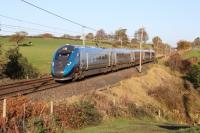
Bay Horse: Driver training on TPE 802s has continued on the WCML in November 2021. On 13th of that month 802204 was the set in use, seen here working from Craigentinny to Preston passing Bay Horse.
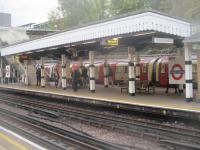
Finchley Central: Until LU Northern Line tube trains arrived at Finchley Central in 1940 (in which year it was renamed from Finchley (Church End)), the station consisted of just two platforms but in that year the far side of the down platform was converted into an island. For many years this served the one-stop shuttle (except at peak hours on weekdays when there were through trains) on the short Mill Hill East branch. With the opening of the Northern Line's Battersea Power Station extension on 20th September 2021, the shuttle was abolished and the branch now enjoys an all day service of through trains to and from central and south London. In the background in this view, a train of LU 1995 stock on a through Mill Hill East service is calling at the outer platform, on the afternoon of Saturday, 13th November 2021. I think this is the only London Underground station that has a pop song named after it, the New Vaudeville Band's 1967 follow-up to their hit 'Winchester Cathedral' in the same year (of which no less a legend than Frank Sinatra recorded a cover version) - unless somebody else knows different!
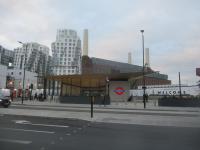
Battersea Power Station [Northern Line]: Exterior of Battersea Power Station, terminus of the new Northern Line branch from Kennington, seen from across the road with the former power station in the background, on 13th November 2021. This latest addition to the London Underground had opened seven weeks earlier on 20th September 2021.

Nuneaton Trent Valley: Just for Beth Crawford: this RHTT leaf train from Kings Norton to Kings Norton was hauled by 66795 with 66704 trailing (you have to believe me here). I was waiting to pick up my wife from a shopping trip, and I'm sure it was light when she started.

Clapham Junction: 378203 with a London Overground service to Stratford via Kensington (Olympia), Gospel Oak and Highbury & Islington waiting to depart at 17.04 from Clapham Junction, on 13th November 2021. This massive interchange station between the lines to and from Victoria and Waterloo has been known as Clapham Junction since its opening in 1863 but that is a misnomer since it is not in Clapham at all but in neighbouring Battersea.
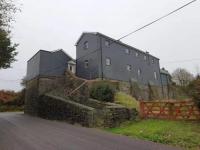
Ballymartle: Ballymartle station, on the Kinsale Junction (Crossbarry) to Kinsale branch, with an unusually shaped private house built to fit the elevated former station site. The pedestrian access up to the former station remains. Kinsale is to the left and Crossbarry to the right. This station opened in 1864 and closed in 1931 with the remainder of the branch.
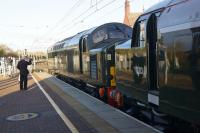
Wigan North Western: A pair of EE Type 4 1Co-Co1s, D345 and D213 depart from Wigan North Western on 13 November 2021 with the 'Double Scotch' railtour from Crewe to Edinburgh.

Bay Horse: D345 and D213 head north through Bay Horse with 'The Double Scotch,' from Crewe to Edinburgh, on a bright, cloudless 13th November 2021. Coaching stock was an Inter-City liveried rake of mainly MkIIIs.
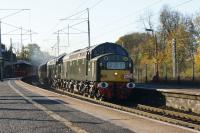
Oxenholme Lake District: D345 and D213 head north through Oxenholme with the 'Double Scotch' railtour from Crewe to Edinburgh on 13 November 2021.
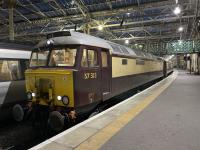
Edinburgh Waverley: The Northern Belle waiting to depart (17:16) Waverley on 13th November 2021, with 57313 leading and 57601 on the rear. I'd had an Avanti trip to Preston and this came in as I was waiting for the 17:35 back home.
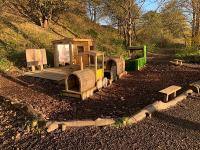
Mount Vernon North: This fanciful train and relocated station is now a feature on the trackbed of the former GHB&CR at Mount Vernon park, a short distance SE of the former station site.

Essex Road: 717022, with a Great Northern suburban service to Moorgate, departing from Essex Road on Saturday, 13th November 2021. The station has a rather creepy atmosphere and few people, even in peak hours, seem to use it.
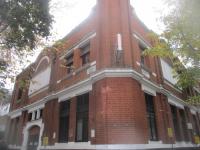
Essex Road: Despite being in a busy residential and business part of the London Borough of Islington, and with its station building on the corner of two main roads, one of which it takes its name from, Essex Road station, now part of the GN suburban system since 1976, is little used. It opened with the line as Essex Road in 1904, was renamed Canonbury & Essex Road in 1922 but the original name was restored in 1948. Despite its name, the entrance is actually situated on Canonbury Road, on the right. This view is on 13th November 2021.
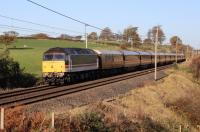
Bay Horse: 47828 was turned out on the rear of LSL's 'Double Scotch' railtour, headed by D345 and D213 from Crewe to Edinburgh, on 13th November 2021. The Inter-City livery of the Brush Type 4 complemented the coaches, except for the Pullman liveried MkII Brake at the rear.
Events
Events from the chronology which occured on this day. This generally lists events before 1995, the creation of the website.
| Year | Companies | Description |
|---|---|---|
| 1767 | Coalbrookdale | First cast-iron rails made. Some of these may have been used on the Carron Iron Works waggonway to Kinnaird. |
| 1916 | Buchanan Street Extension (Caledonian Railway) | Balornock Shed opened. |
| 1961 | Dowlais and Merthyr Joint Line | Closed to passengers. |
| 1983 | Mallaig Extension (West Highland Railway) | Arisaig signal box closed. |
| 2014 | Hitachi Rail Europe | The first of 122 Class 800 trainsets for the East Coast Main Line and Great Western Main Line was unveiled at Hitachi^s factory at Kasado in southwest Japan. |
News
These are old news items which which occured on this day. This generally lists events after 1995, the creation of the website.
| Year | Companies | Description |
|---|---|---|
| 2002 | 10 tender for ScotRail Franchise | 10 companies have tendered for the ScotRail franchise. The successful application will be announced in 2003. |
| 2007 | Final hurdle cleared at Kings Cross [Network Rail] | Details of extensive refurbishment / enhancement plans have now been agreed for Kings Cross and the surrounding area - see article [Network Rail] |
| 2007 | South Sub rail views sought [Evening News] | The country^s top transport bodies have been given four weeks to submit their views on plans for the reopening of Edinburgh^s South Side Suburban rail line. Last week the Scottish Parliament^s petitions committee agreed to seek responses from a number of groups, including Network Rail, Transport Scotland, Lothian Buses and Scotrail. The Capital Rail Action Group and E-Rail are petitioning the parliament to back the reintroduction of passenger services on the line, which closed in 1962. |
| 2009 | GE PowerHaul locos for Freightliner arrive in UK [Freightliner PR] | Freightliner Group Ltd and GE Transportation announced on 9 November 2009 that Freightliner have taken delivery of the first PowerHaul locomotives – introducing state-of-the-art technology to the UK’s rail freight market |
| 2009 | State taking over key rail route [BBC News Article] | The government takes control of the East Coast Main Line when operator National Express hands back the franchise later. |
| 2009 | Woman trapped under train [Lancaster Guardian] | A WOMAN rescued by firefighters after she became trapped underneath a train at Lancaster Station appears to have escaped serious injury. [From Mark Bartlett] |
| 2013 | Councils give £45m to Bicester-Bletchley rail section fund [BBC News] | Seven councils have contributed a total of £45m to help fund the restoration of a section of rail line between Cambridge and Oxford. The section between Bicester and Bletchley was closed in 1963, but has been earmarked for restoration as part of a scheme to link the two cities. The Department for Transport said work on the new section could begin by 2017. [From Mark Bartlett] |
| 2014 | Eurostar unveils new 200mph Channel Tunnel train [Telegraph] | A new 200mph state-of-the-art train has been unveiled in London by Channel Tunnel high-speed train company Eurostar. Built by German firm Siemens and capable of carrying 900 passengers, the e320 train will go into service at the end of 2015. |
| 2014 | London Underground extension approved [IRJ] | BRITAIN^s secretary of state for transport, Mr Patrick McLoughlin, has approved a £1bn 5km extension to the Northern Line of London Underground (LU). Construction of the underground extension from Kennington via Nine Elms to Battersea will start in spring 2015 and should be completed by 2020. [From Richard Buckby] |
| 2014 | First Hitachi Class 800 trainset unveiled [Railway Gazette] | UK: The first of 122 trainsets for inter-city services on the East Coast and Great Western main lines was unveiled at Hitachi’s factory at Kasado in southwest Japan on November 13. |
| 2015 | Rail summit urged amid ^chaos engulfing the system^ [Herald] | A summit on Scotland^s railways is needed to deal with the ^chaos currently engulfing the system^, according to a Labour MSP. Neil Findlay wants Transport Minister Derek Mackay to bring together employee and passenger representatives, the board of ScotRail and a cross-party group of transport experts to discuss issues affecting train services. It was revealed earlier this month that ScotRail has been fined more than £250,000 over three months for failing to meet strict standards for trains and stations. Figures show the franchise, taken over by operator Abellio in April, was hit with £265,282 in penalties between July and September. ScotRail fell short in eight of 17 areas of station performance over the period, including toilets, litter, shelters and CCTV and security. |
| 2016 | New London Overground concession begins [IRJ] | ARRIVA Rail London took sole charge of the London Overground orbital suburban rail network on November 13 with the start of a new seven-and-a-half-year operating concession. Arriva took over operations from London Overground Rail Operations (Lorol), a 50:50 joint venture between Arriva and MTR, which has run the network since 2007. The contract, which was awarded by Transport for London in March, is worth around £1.5bn and includes an option for a two-year extension. The new concession encompasses all London Overground lines, including the West Anglia lines from Liverpool Street to Enfield Town, Cheshunt, and Chingford, which, together with the Romford - Upminster branch, recently came under TfL control. A new fleet of 45 Bombardier trains will be introduced on these lines from 2018 onwards. [From Richard Buckby] |
| 2017 | Plan for underground line to run under Cambridge centre [Times] | Britains first new underground railway in decades could be built as part of a radical plan to run trains into the heart of Cambridge. Transport chiefs want to create a tram link that will travel through four miles of tunnels beneath the city. It is hoped that the line, which has the backing of senior figures in central government, can be built in six years and could be open by the middle of the next decade. |
| 2018 | Around 70 trains cancelled every day as ScotRail^s performance plummets [The Herald] | THE number of trains being cancelled across Scotland has risen to a new high, with the latest figures showing an average of around 70 services were scrapped every day. |
| 2018 | FirstGroup^s new boss to bid for more UK rail operations despite loss [The Guardian] | Transport group reports increased losses of up to £4.6m under challenging conditions. The new boss of FirstGroup has pledged to bid for more UK rail operations despite the beleaguered transport group warning that profits in its existing rail business were in jeopardy. Matthew Gregorys appointment as chief executive was announced with immediate effect on Tuesday, as FirstGroup reported increased losses, up to £4.6m pretax for the six months to 30 September. |
| 2019 | Every Glasgow railway station mapped out amid disabled accessibility row [Evening Times] | The Evening Times have mapped out every railway station in Glasgow according to their accessibility status. |
